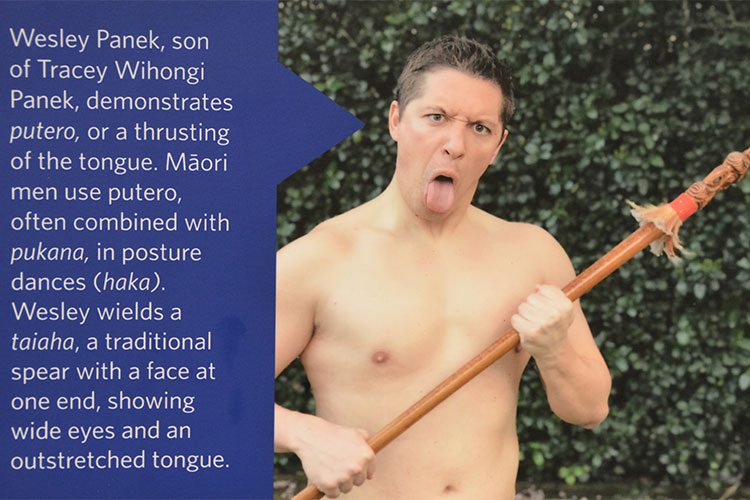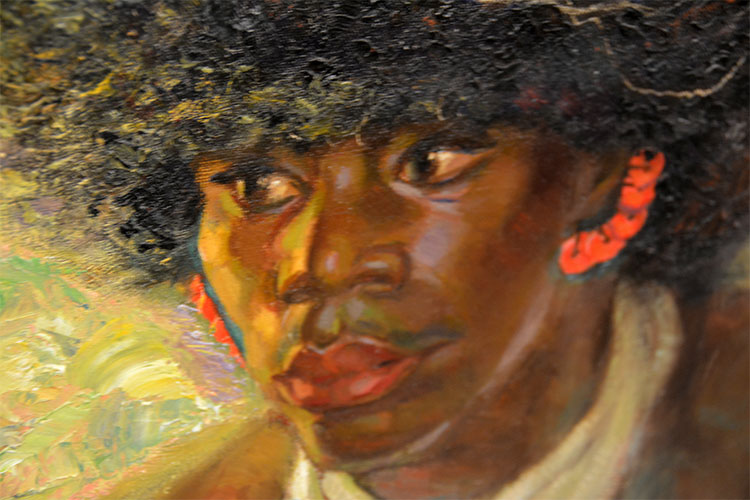‘Face to Face’ opens at the Hearst
Fourteen undergraduates co-curated a new exhibition at the Hearst Museum, exploring faces through time and different cultures

March 9, 2018

This Ibibio carving of a leopard with a human-like face may represent shapeshifting beliefs in West Africa and the concept that every person has two souls: one in their body and one in the wild. (UC Berkeley Public Affairs photo by Hulda Nelson.)
In Romeo and Juliet, Shakespeare asked, “What’s in a name?” Now, a student co-curated exhibition at UC Berkeley’s Phoebe A. Hearst Museum of Anthropology ponders the messages conveyed by the human face directly or subtly via the globe’s diverse cultures over the centuries.
“Face to Face: Looking at Objects That Look at You,” opening on Saturday (March 10), features a mix of Mexican and African masks, Hopi Kachina dolls, paintings of peoples of Oceania, Yoruba and Chinese carvings, Moche pottery, Taiwanese puppets, Swedish mannequins and much more selected from the Hearst’s estimated 3.8 million objects.
The goal is to spark conversation among visitors about crucial current issues and new ways of viewing the world.
The display winds around the world from Russian iconography from the 16th century and wooden masks from the West African Mende people’s all-women’s Sande Society to Hanuman, the Hindu monkey god, as well as fierce warriors on Japan’s Satsuma stoneware largely made to satisfy Western tourists’ preoccupation with the Samurai in the late 19th century.
Faces of power, race, spirituality
“When we’re evolutionarily primed to respond to faces, it’s easy to see why we would respond strongly to an exhibit like this,” said Katie Fleming, the museum’s gallery manager and education coordinator.
As explanatory text for “Face to Face” notes: “A focus on faces highlights crucial questions about power, race, spirituality, and especially in this day and age self(ie)-representation. In depicting a face, after all, we can both glorify and demean someone. In judging a face, we can both love and fear someone. What can we gain if we look closely at how we look at faces, and what they say when they look at us?”
The exhibition, which is open through August, is the product of a fall 2017 freshman seminar led by Adam Nilsen, the Hearst’s head of education and interpretation, who also researches how people think and learn about Earth’s human inhabitants.
Nilsen’s class provided students with a close-up look at the inner workings of a museum of culture, object care and exhibition design, community-based research and storytelling and the museum’s role in the 21st century.
Using real objects to tell real stories
“At the Hearst … we use real objects to tell real stories about real people, inviting visitors to see the world through the eyes of people beyond themselves,” Nilsen wrote in a summary for his seminar.
Fourteen students got an opportunity to do just that, and settled on sets of objects from the Hearst’s collection that focus on the face. The museum’s conservator vetted the materials, and students consulted with community members for whom the objects have meaning.
They designed the display around six subject areas:
- Different ideas about what makes the ‘ideal’ face.
- What’s in an expression?
- Beings that fuse human, animal and spirit across cultures.
- Why some faces on object look more real or lifelike than others.
- Depicting people as curiosities to suit collectors.
- The power of craftspeople depicting people of another culture.
Students-turned-curators
As an anthropology student, Alexandra Perkins said co-curating “Face to Face” let her share her passion for forgotten parts of history. She oversaw the selection of large, 1920s oil paintings of Oceania men, women and children by American socialite Carolyn Mytinger that attempted to document what she misguidedly perceived as a “race” that was among the least mixed in a more accurate form than black-and-white photos could do.
“I’d like to be a curator when I graduate,” said Perkins, 19, of Denver. “This program really cemented my love for museum work.”
Lena Zhou, 18, said the course and exhibition work underscored her interest in studying art history, sociology and data science.
A native of Connecticut who recently relocated to the Bay Area after nine years in Shanghai, Zhou chose the Ibibio carved leopard figure for “Face to Face.”
“I was captured by the leopard figure’s intense, unnerving expression and its dynamism, which was exemplified by the positioning of its tail,” she explained. “I was also extremely drawn to its humanistic facial features and expression. It has eyebrows, which you wouldn’t really find on a leopard.
“I’m so thankful that I had the opportunity to be a part of this process, from learning about the subtleties of museum curation to physically and tangibly interacting with artifacts. It’s extremely rewarding to be able to see my seminar’s work and research displayed within the Hearst Museum.”
Plan a visit
Learn more details about hours, directions to the Hearst, etc.












